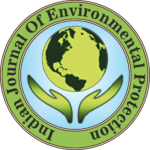IJEP 42(7): 806-812 : Vol. 42 Issue. 7 (July 2022)
Piyali Das* and Mithra Dey
Assam University, Department of Ecology and Environmental Science, Silchar – 788 011, Assam, India
Abstract
In the present study the selected heavy metals, such as zinc (Zn), cadmium (Cd), chromium (Cr), lead (Pb), copper (Cu) and nickel (Ni) were determined in water, sediment and gill, liver, muscle of fish H. fossilis, L. rohita and O. niloticus from different aquaculture ponds of Badarpur, Karimganj district, Assam. The concentration of heavy metals varied significantly among fish species and their organs. Among the three organs muscles contained the lowest concentrations of all metals. In most studied fishes, the liver was the target organ for Cu, Zn and Fe accumulation. Pb and Cd, however, exhibited their highest concentrations in the gills. The result of the study revealed that the concentration of heavy metals in water, sediment and in different species were within the recommended limit set-up by different organizations and are considered to be safe for human consumption.
Keywords
Heavy metals, fish species, accumulation
References
- Chutia, S.J., et al. 2018. Trends in fish production of Assam: An analysis. Int. J. Curr. Microbiol. Appl. Sci., 7(11): 3417-3422.
- Sarkar, U.K., et al. 2016. Conserving wetlands- An effective climate change adaptation in India. ICAR- Central Inland Capture Fisheries Institute, Barrackpore, Kolkata.
- Khan, M.A. 2008. Effect of soil contamination on some heavy metals content of Cannabis sativa. J. Chem. Soc. Pakistan. 30(6):805-809.
- Zhang, F.P., et al. 2010. Response of microbial characteristics to heavy metal pollution of mining soils in Central Tibet, China. Appl. Soil Ecol.,45: 144-151.
- ECDG. 2002. Heavy metals in waste (final report). European Commission DG ENV. E3 Project ENV.E.3/ETU/0058.
- Basta, N.T., J.A. Ryan and R.L. Chaney. 2005. Trace element chemistry inresidual-treated soil: Key concepts and metal bioavailability. J. Env. Quality.34: 49-63.
- Zhang, Z., et al. 2007. Analysis of heavy metals of muscle and intestine tissue in fish- In banan section of Chongqing from Three Gorges reservoir, China. Polish J. Env. Studies. 16(6): 949-958.
- FAO/WHO. 1984. List of maximum levels recommended for contaminants (Second series CAC/FAL). Joint FAO/WHO Codex Alimentarius Commission, Rome. 3:1-8.
- Lau, S., et al. 1998. Accumulation of heavy metals in freshwater molluscs. Sci. Total Env., 214: 113-121.
- Maurya, A., L. Kesharwani and M.K. Mishra. 2018. Analysis of heavy metal in soil through atomic absorption spectroscopy for forensic consideration. Int. J. Res. Appl. Sci. Eng. Tech., 6(6):1188-1192.
- Zhao, S., et al. 2012. Role of living environments in the accumulation characteristics of heavy metals in fishes and crabs in the Yangtze river estuary, China. Marine Poll. Bull., 64:1163-1171.
- Gorur, F.K., et al. 2012. Radioactivity and heavy metal concentrations of some commercial fish species consumed in the Black sea region of Turkey. Chemosphere. 87:356-361.
- Hernandez, P.P., et al. 2006. Sub-lethal concentrations of water borne copper are toxic to lateral line neuromasts in zebrafish (Danio rerio). Hearing Res., 213:1-10.
- Abdel, T.M., M.A.A. Mousa and F.E. Abbass. 2007. Growth performance and physiological response of African catfish, Clarias gariepinus (B.) fed organic selenium prior to the exposure to environmental copper toxicity. Acquaculture. 272:335-345.
- Dhaneesh, K.V., et al. 2012. Bioaccumulation of metals on reef associated organisms of Lakshadweep Archipelago. Food Chem., 131:985-991.
- Qadir, A. and R.N. Malik. 2011. Heavy metals in eight edible fish species from two polluted tributaries (Aik and Palkhu) of the river Chenab, Pakistan. Biol. Trace Element Res., 143:1524-1540.
- Authman, M.M.N., et al. 2015. Use of fish as bio-indicator of the effects of heavy metals pollution. J. Aquatic Res. Develop., 6(4):1-13.
- Isaac, O.A, I.E. Ukinebo and A.B. Oluwakemi. 2019. Determination of selected heavy metal and analysis of proximate composition in some fish species from Ogun river, Southwestern Nigeria. Heliyon. 8: 502-512.
- Moselhy, K.M.E., et al. 2014. Bioaccumulation of heavy metals in some tissues of fish in the Red sea, Egypt. Egyptian J. Basic Appl. Sci., 1(2):97-105.
- Mauryaa, P.K., et al. 2019. Bioaccumulation and potential sources of heavy metal contamination in fish species in river Ganga basin: Possible human health risks evaluation. Toxicol. Reports. 6:472-481.
- Khaled, A. 2004. Seasonal determination of some heavy metals in muscle tissues of Siganus rivulatus and Sargus sargus fish from El-Mex bay and eastern harbour, Alexandria, Egypt. Egyptian J. Aquatic Biol. Fisheries. 8(1):65-81.
- Abdallah, A.M.A. 2008. Trace element levels in some commercially valuable fish species from coastal waters of Mediterranean sea, Egypt. J. Marine Sci., 3(1):114-122.
- Nweeze, N.O., L.B. Mahmood and U.I. Aisha. 2014. Lithological studies and algal diversity, the useful tool for assessment of fish pond water quality. Asian Academic Res. J. Multidisciplinatin Auline.
- Sfakianakis, D.G., et al. 2015. Effect of heavy metals on fish larvae deformities: A review. Env. Res., 137:246-255.
- Jezierska, B. and M. Witeska. 2006. The metal uptake and accumulation in fish living in polluted waters. NATO Science series. Springer, The Netherlands.
- Creti, P., F. Trinchella and R. Scudiero. 2010. Heavy metal bioaccumulation and metallothionein content in tissues of the sea bream Sparus aurata from three different fish farming systems. Env. Monit. Assess., 165:321-329.
- Farag, A.M., et al. 2006. The effect of chronic chromium exposure on the health of Chinook salmon (Oncorhynchus tshawytscha). Aquatic Toxicol., 76:246-257.
